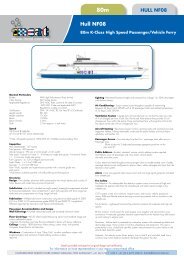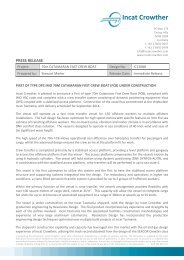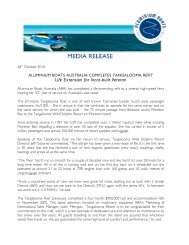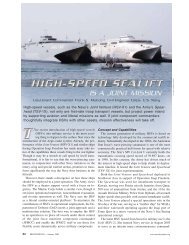US NAVY'S - Incat
US NAVY'S - Incat
US NAVY'S - Incat
You also want an ePaper? Increase the reach of your titles
YUMPU automatically turns print PDFs into web optimized ePapers that Google loves.
NO RESTING ON LAURELS: MAN DIESEL IS ALREADY<br />
DEVELOPING THE TECHNOLOGIES WHICH WILL BUILD<br />
ON THE FAVOURABLE CONSUMPTION AND EMISSIONS<br />
OF THE 28/33D HIGH POWER DENSITY ENGINE.<br />
by obligations to reduce emissions of the greenhouse gas<br />
carbon dioxide (CO2). Since CO2 emissions are directly<br />
proportional to fuel consumption, the engine developer’s<br />
challenge is now to reduce harmful emissions without<br />
increasing fuel consumption or, in the best case, reduce<br />
both simultaneously.<br />
“A major challenge is emissions of oxides of nitrogen<br />
(NOx), which are always a special focus of legislation<br />
affecting large marine diesel engine emissions”, notes Dr.<br />
Franz Koch, Vice President, Diesel Engines at MAN Diesel<br />
in Augsburg, Germany, where the 28/33D is built.<br />
Nitrogen makes up 4/5 of the air around us but is<br />
very unreactive at ambient temperatures. However,<br />
it combines readily with oxygen – the other 1/5 of the<br />
atmosphere - at the temperatures and pressures reached<br />
in a diesel combustion chamber. Outside the combustion<br />
the NOx formed and emitted is instrumental in the<br />
formation of low level ozone, acid rain and the overfertilising<br />
the land and the sea.<br />
“The immediate target for engine builders is IMO Tier<br />
2, the latest directive from International Maritime<br />
Organisation which comes into force in 2011 and specifies<br />
a considerable NOx reduction vis-à-vis Tier 1,” Koch<br />
confirms.<br />
<strong>Incat</strong> THE Magazine Issue 36 19
















